“The Ambassadors” by Hans Holbein the Younger – A Detailed Analysis
From friendship to feuds between the church and royal families, The Ambassadors (1533) by Hans Holbein is a painting steeped in the riches of history. It is a telling tale of two ambassadors and one we will uncover in the article below.
Who Was Hans Holbein the Younger?
Hans Holbein the Younger was a German artist who was born in Augsburg. His date of birth was approximately around 1497 to 1498. He was born into an artistic family; his father was Hans Holbein the Elder, who was a painter whose art has been characterized as Late Gothic. His brother, who was older by a few years, Ambrosius Holbein, was also a multi-talented artist.
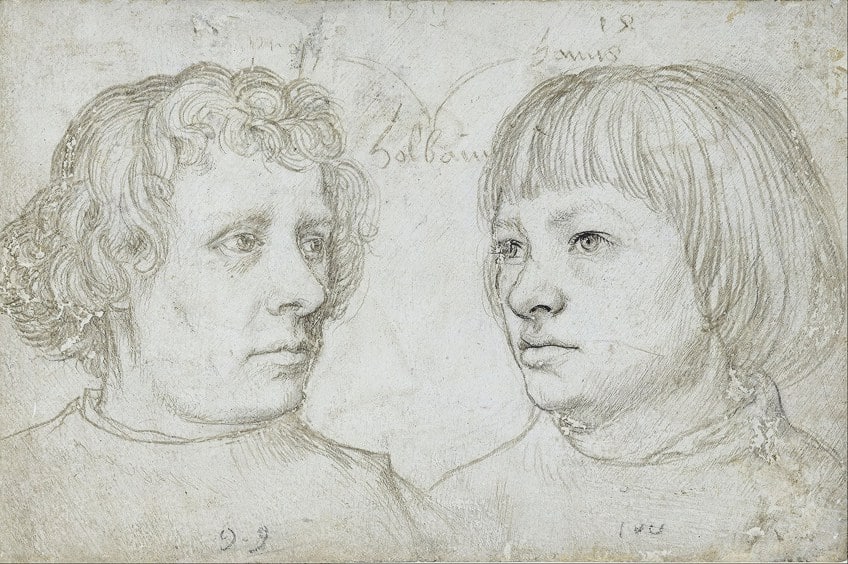
He was known for having traveled to various countries in Europe, namely Basel in 1515, and in 1519 he was part of the artist’ guild based in Basel. He also traveled to Switzerland, Italy, France, and England, where he lived for several years. He was a notable portrait painter and painted many notable figures of the Royal court and outside it.
His style of art influenced many others in England and his artworks were widely copied, one of which was his widely referred to paintings of King Henry VIII. Holbein reportedly died in 1543 in London, England.
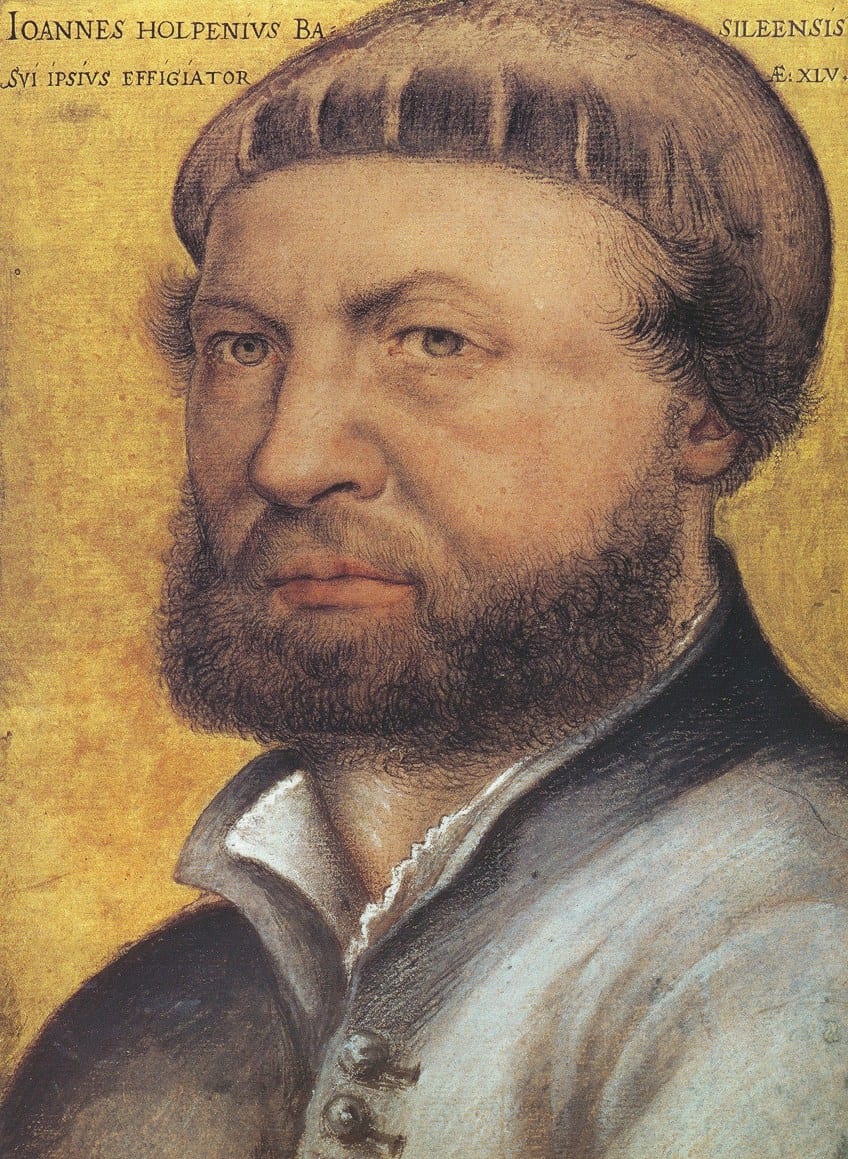
The Ambassadors (1533) by Hans Holbein the Younger in Context
The Ambassadors painting by Hans Holbein the Younger also goes by the title of Jean de Dinteville and Georges de Selve, who are the sitters in the composition. This may appear as a simple portrait painting of two men, but upon closer inspection, there is a wealth of symbols in the subject matter.
We will discuss this painting in more detail providing a brief socio-historical overview, discussing who the two men are in the painting, and the political and social climate at the time it was painted. We will then give a visual description of the subject matter and discuss what art elements and principles make up the composition.
| Artist | Hans Holbein the Younger |
| Date Painted | 1533 |
| Medium | Oil on oak |
| Genre | Portrait and Still Life painting |
| Period / Movement | Northern Renaissance |
| Dimensions | 207 x 209.5 centimeters |
| Series / Versions | N/A |
| Where Is It Housed? | The National Gallery, London, England |
| What It Is Worth | N/A |
Contextual Analysis: A Brief Socio-Historical Overview
Hans Holbein’s The Ambassadors was painted in 1533. This was a period in England’s history when Henry VIII was the ruling king. He took over the throne in 1509, which was when his father Henry VII died. A few years prior, in 1502, his brother Arthur died, and Henry VIII married Catherine of Aragon, who was originally married to Arthur.
King Henry VIII and Catherine lost several children and their attempts to procreate a male heir for the throne and uphold the ultimate continuation of the king’s lineage proved unsuccessful; Mary I was the only child who survived out of their reported seven children.
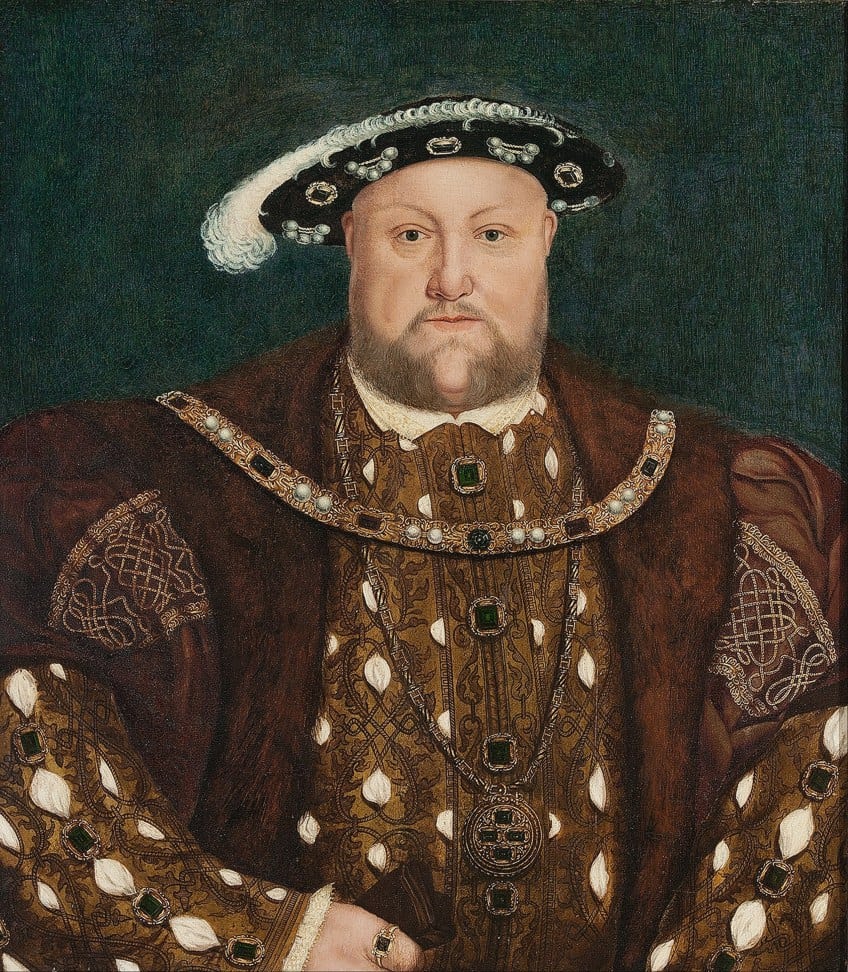
King Henry VIII was known for wanting a male heir, and he reportedly wanted to remarry, with his affections turned to Anne Boleyn, who was Catherine’s lady-in-waiting, which is like an assistant to the queen.
The king wanted to annul his marriage with Catherine of Aragon but was denied by Pope Clement VII. Apparently, Pope Clement VII was dissuaded by Charles V, who was the Holy Roman Emperor and King of Spain, because Catherine was his aunt.
This disagreement led King Henry VIII to break away from the Catholic Church and marry Anne Boleyn in 1533, the same year that Thomas Cranmer, the Archbishop of Canterbury, allowed the divorce between Henry VIII and Catherine.
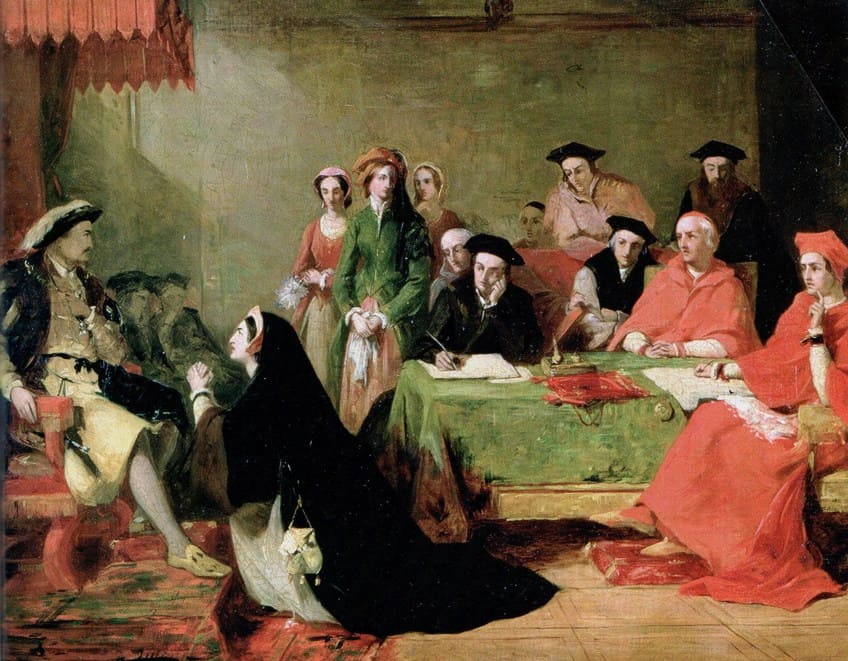
Who Are the Ambassadors?
The question arises, what do the ambassadors in Holbein’s painting have to do with what seems to be royal and religious feuds? We need to look to the year 1534, when King Henry VIII also became what is known as the Supreme Head of the Church of England, which the pope originally ruled.
The English Parliament granted this appointment through their approval of the Act of Supremacy. However, this caused the division between the Catholic Church in Rome, Italy, and the Church of England. This is also referred to as the English Reformation.
Other countries like France, at the time King Francis I, also sent ambassadors to King Henry VIII. Among these ambassadors was Jean de Dinteville, who is the French ambassador/diplomat in London, the figure we see standing to the left in Hans Holbein the Younger’s painting. The man standing to the right is another French ambassador/diplomat Georges de Selve.

Apparently, Jean de Dinteville was sent by King Francis I to bring back information regarding the situation of the state of the church in England, which had far-reaching effects. He was almost like a middleman between King Henry VIII and King Francis I. Reportedly, Dinteville also attended King Henry VIII and Anne Boleyn’s wedding.
Georges de Selve, another French diplomat, was in England and apparently was Dinteville’s friend, and he commissioned the painting as a celebration of their friendship. The two were painted when they were both in England at the time when Hans Holbein the Younger was living there around 1532.
Formal Analysis: A Brief Compositional Overview
In Hans Holbein’s The Ambassadors, there is a significant amount of detail. This was a common trait of Northern Renaissance art, also described as “naturalism”. Below we will provide a visual description of the subject matter, all of which have also been found to be symbolic of the Catholic Church and King Henry VIII’s break from it. This will be followed by an analysis of the artistic techniques that Holbein the Younger utilized.
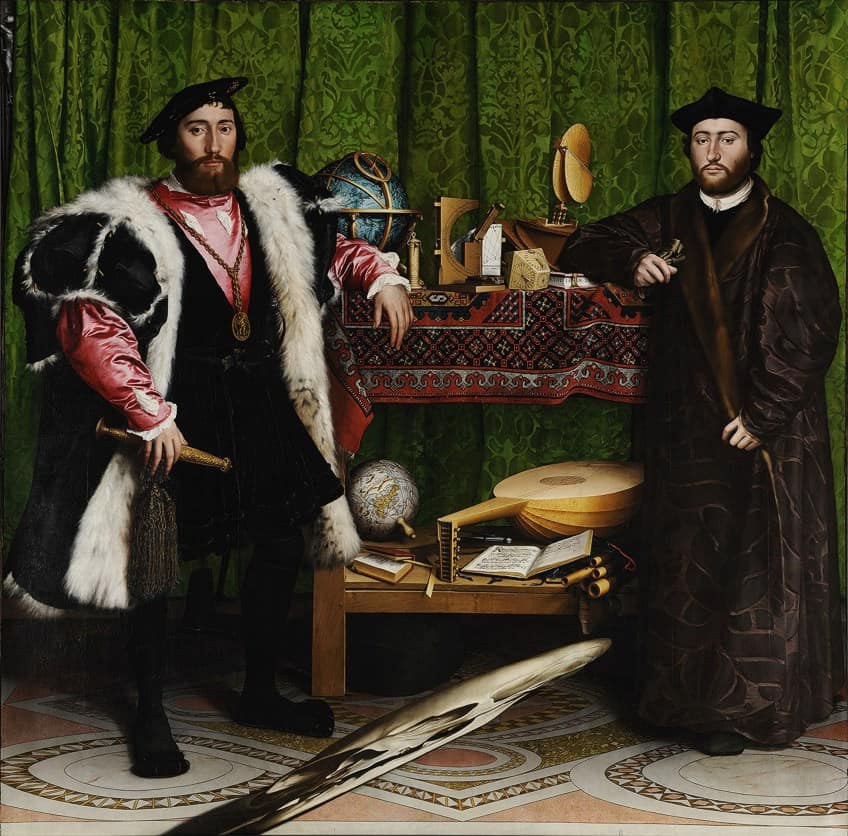
Visual Description: Subject Matter
The Ambassadors painting depicts two men standing at full length and leaning with their elbows against a table between them. They are both looking straight at us, the viewers. There are various paraphernalia on the table, ranging from artistic to scientific, which we will discuss further below. Behind the men is a large green curtain filling up the background and the floor is a tiled mosaic, which was modeled after the Cosmati (otherwise also referred to as the “Cosmatesque technique”) Pavement in Westminster Abbey in front of the High Altar.
It was commissioned by King Henry III in 1268 and this was also reportedly where Anne Boleyn’s coronation was held.

If we look at the figure to the left, Jean de Dinteville, his style has been described as “flamboyant”. He is wearing a long-sleeved pinkish silk/satin shirt over a white long-sleeved undershirt with what appears to be a velvety black tunic over it. Over these clothes he is wearing a large fur-lined coat, the sleeves cropped and puffed just below his shoulders.

He is wearing a black beret-like hat and black shoes with black stockings. In his right hand, he is holding a dagger in its sheath with tassels hanging from it. Around his neck is a large gold chain with a pendant depicting St. Michael. This could allude to the fact that he was part of the Order of St. Michael at the time. The upper part of his sword is visible on his left side under his coat.
On his dagger, we can also see an inscription that reads “AET SV Æ 29”, which indicates his age as 29 years old.

If we look at the figure to the right, who is Georges de Selve, we will see that he is wearing a simpler costume, more specifically a full-length robe with the tip of his shoe pointing out from underneath it. His robe appears to be a deep purple color and the inner lining appears brown.

His headdress is also black in color. His right elbow is resting on a book on the table beside him and he is holding what looks like gloves in his right hand. His left hand is loosely holding on to his robe. His outfit has been described as more “clerical” in style.
On the side pages of the above-mentioned book is another inscription that reads “AETAT IS SV Æ 25”, which indicates he is 25 years old.

Let us look at the items on the table between the two men, which have an upper and lower shelf. On the upper shelf of the table, which has a beautiful carpet over it, to the left and closer to Jean de Dinteville, is a celestial globe.
To the right, closer to Georges de Selve, are several mathematical devices to measure the sunlight and other astronomical details of the sky.
Beginning from the left of the top shelf, these items include a Shepherd’s dial, an Equinoctial dial, a Quadrant, a Polyhedral sundial, a Torquetum, as well as a book, on which the elbow of Georges de Selve is resting.
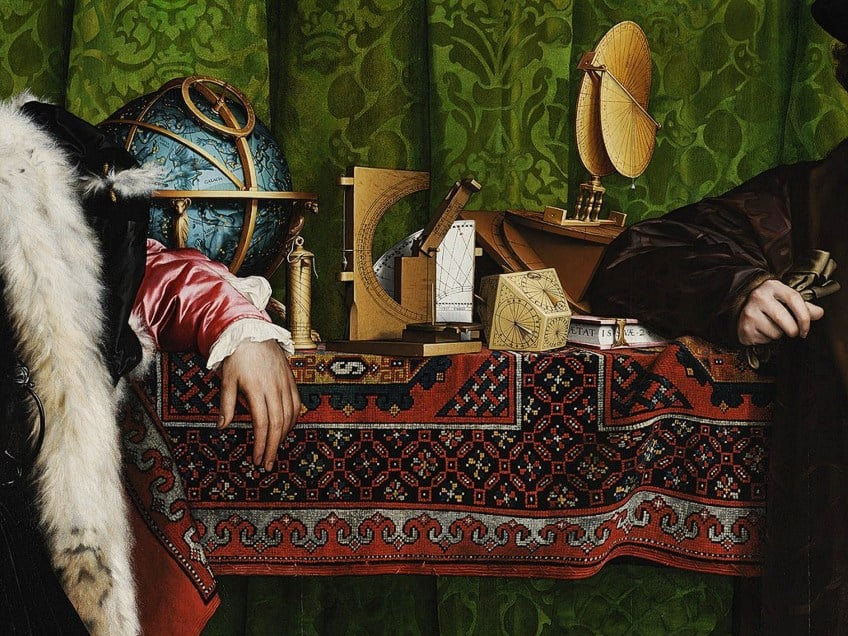
If we look at the bottom shelf, again closest to Jean de Dinteville to the left, is another globe, but this is a terrestrial one. There are primarily musical instruments on this shelf and hymn books. The closed book to the left is reportedly an arithmetic book with what appears to be a wooden set square, which assists in drawing correct angles, bookmarked in it. This book has reportedly been identified as A New and Well-founded Instruction of All Merchant Arithmetic (1527) by the German Peter Apian, who was well-reputed in the fields of astronomy and mathematics, with various other publications.
The other book to the right, and partly resting on several flutes in a casing, is an open Luther’s Hymn Book. We are also able to read the exact hymn on it. Reportedly, the two hymns are “Come Holy Ghost” and “The Ten Commandments”.
To the right is a large lute, and if we look at it closely one of its strings is snapped. Near the background, we see what appears to be another mathematical device, a metal compass. Underneath the table, we will notice a dark object, which appears to be a larger lute lying with its soundboard facing down.

Below, on the tiled floor, we can see what is possibly the strangest and mostly unrecognizable object. This object is known as the “anamorphic skull”, which relates to anamorphism, being a distorted perspective of an image.
This was also a common technique during the Renaissance period.
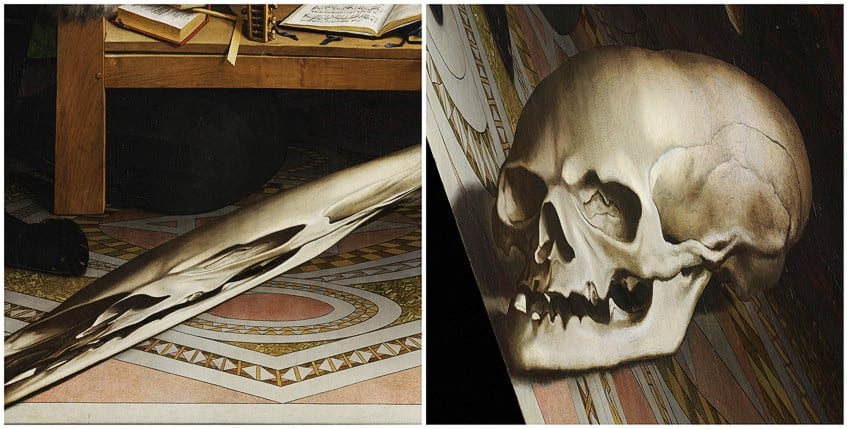
When viewing the image normally, from the front, we only see an elongated shape, but it can be viewed by standing at an angle near the lower right of the painting. In the top left corner of the composition is a crucifix depicting the figure of Jesus Christ on the Cross.
This is partially covered by the green curtain.
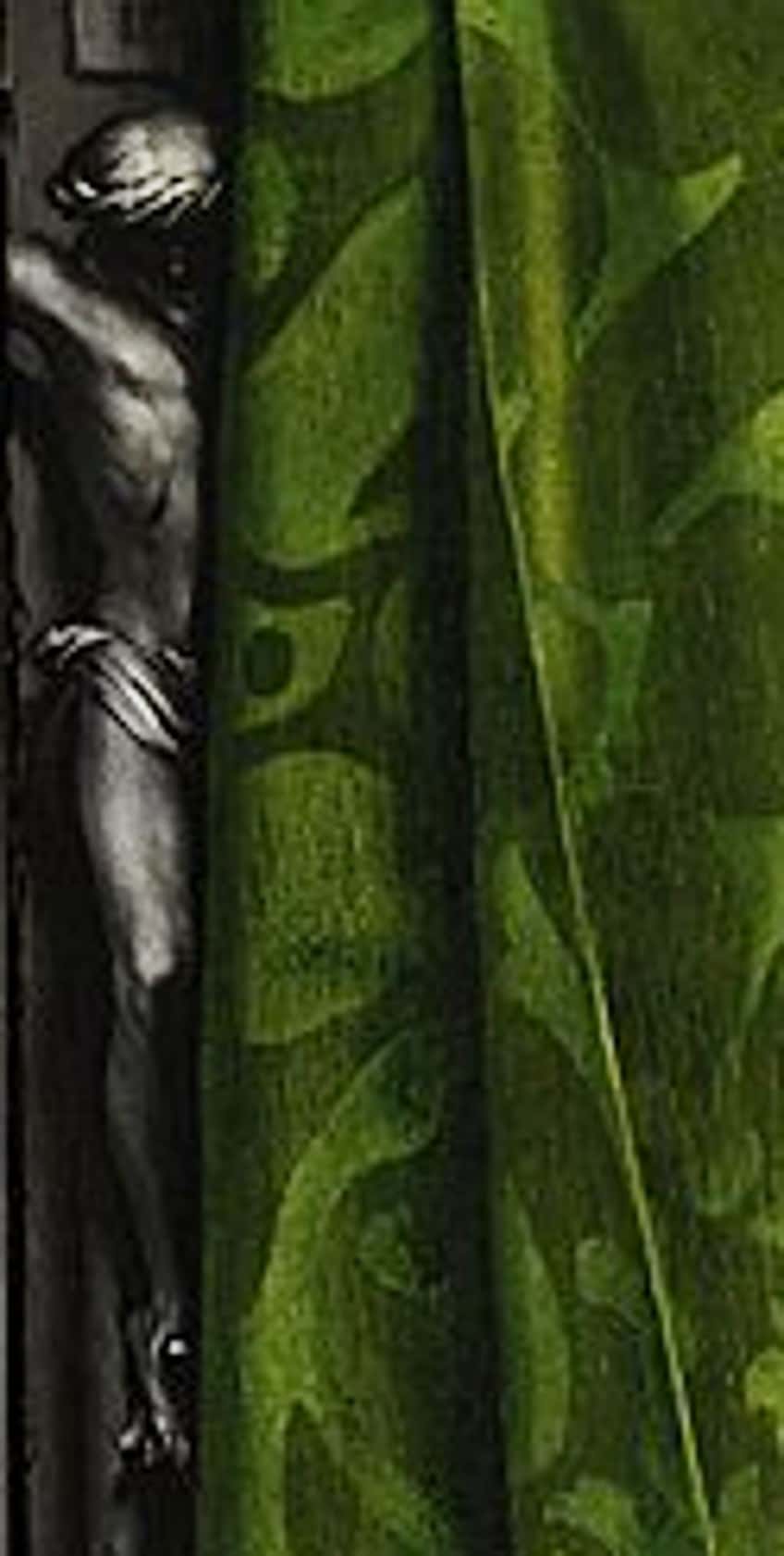
Color and Value
If we look at The Ambassadors, the artist utilized various hues like the cooler green in the background and warmer colors like reds and pinks in the carpet and clothing. There are dark and light color values in this painting, notable by the dark or black clothing and the lighter colors in the white of the fur and the light-colored objects on the table. The lower portion of the composition, the floor, appears lighter in color compared to the upper portion where we see the curtains.
Altogether, there is a contrast of color schemes in this painting, creating a harmonious effect.
Texture
Hans Holbein the Younger utilizes various implied textures, all ranging between soft and hard surfaces. In The Ambassadors painting, these textures all showcase his unique skills as an artist to create a naturalism, which is also coupled with his utilization of oil paint, giving it a heightened realism.
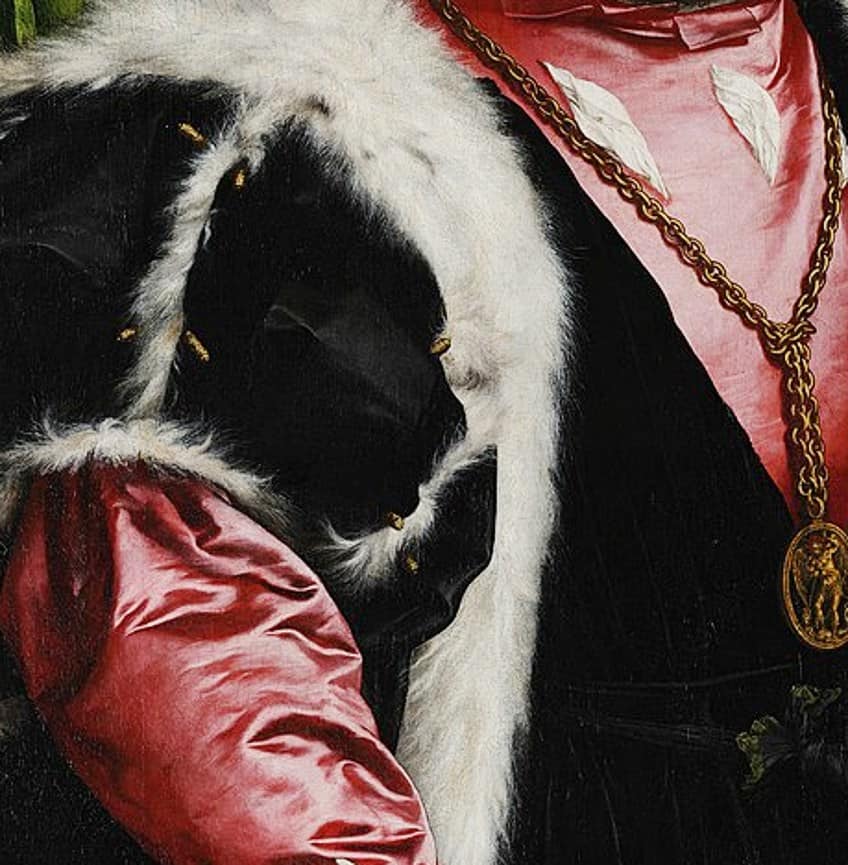
While there are numerous examples, some include delicate details of the fur on Jean de Dinteville’s coat, the silky sheen of his pink shirt, and the tassels hanging from his dagger. We also see the intricate detailing on the two globes and the harder wooden surfaces of the musical instruments.
Hans Holbein the Younger creates an intriguing realism that makes us, the viewers, feel as if we are a part of the scene.
Line, Form, and Shape
A vertical line is created by the two full-length figures and the folds in the curtains behind them. This is contrasted by the horizontal shape of the table between them. There are various shapes and forms in this composition, notably spherical shapes from the globes and the diagonal line from the anamorphic skull in the foreground, which has been described as almost parallel to the position of the lute on the lower shelf of the table.

Space
The spatial depth in The Ambassadors painting has been described as shallow. There is a minimal amount of space between the figures and the edge of the painting in the foreground. The curtains in the background are also placed seemingly directly behind the table and figures, bringing them more into the foreground.
We also see the lute on the lower shelf portrayed in a foreshortened perspective.

Hans Holbein: The Ambassadors Symbolism
Possibly one of the most important aspects of The Ambassadors by Hans Holbein is the symbolism related to all the above-mentioned objects. Each object is believed to portray various socio-economic, political, and religious aspects related to two figures and the events that surrounded them at the time.
The globes, the carpet, and various devices could allude to ideas about travel and trade, as well as the European influence on other lands due to colonization.
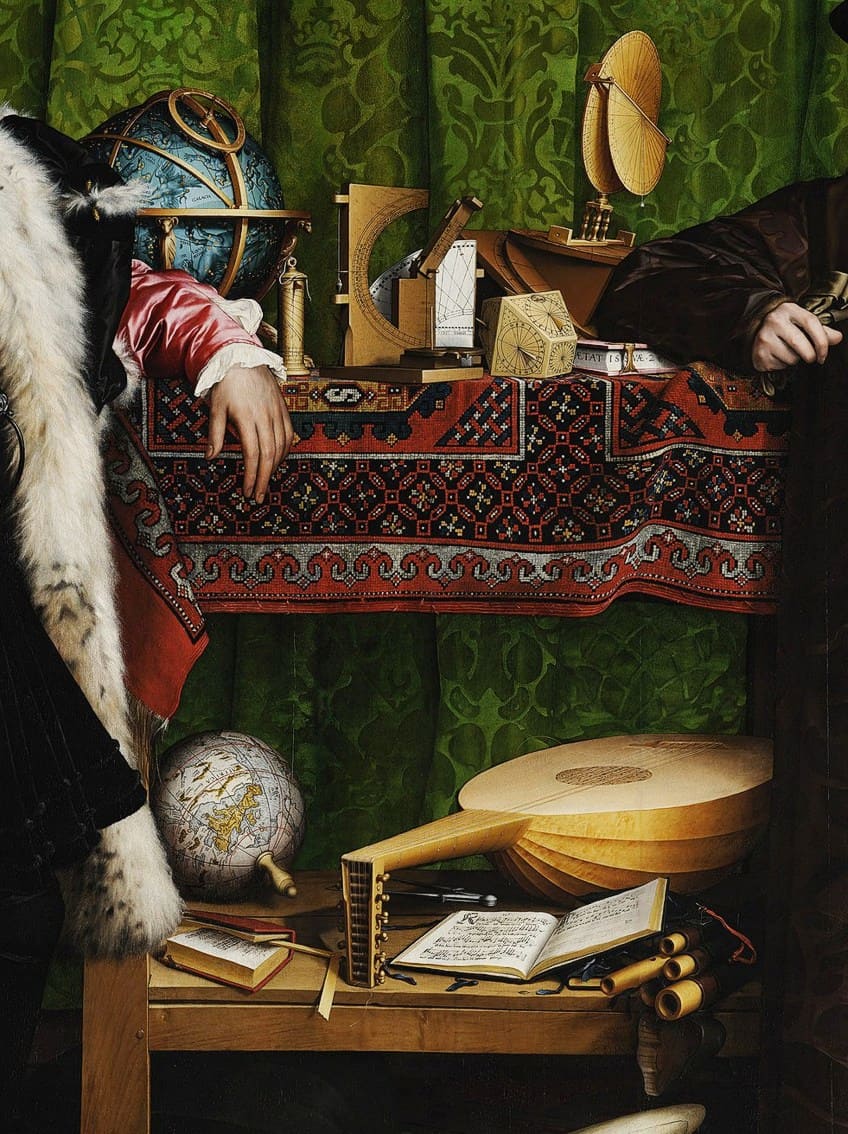
Furthermore, the lute’s snapped string has been believed to allude to the division between the Catholic Church and England and the Protestant Reformation. Additionally, the anamorphic skull is believed to symbolize death and mortality. This is typically referred to as a memento mori or Vanitas painting and is a characteristic of Northern Renaissance paintings from the 16th century.
The composition has also been divided into different parts; namely, the upper part, representing the celestial or heavenly aspects of life, and the lower part, representing the earthly aspects.
Similarly, the two figures are symbolic too, Jean de Dinteville to the left appears more decadent and “active” in his demeanor compared to Georges de Selve, who appears quieter and calmer – some also describe him as “contemplative”.
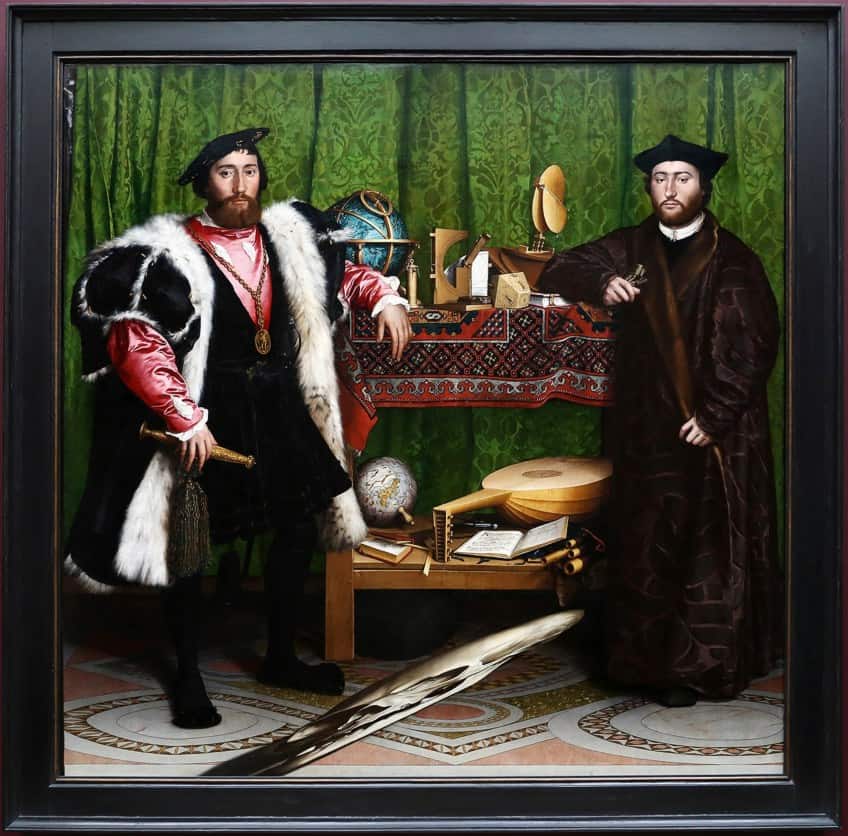
The Ambassadors: More Than Meets the Eye
There is more than meets the eye in The Ambassadors by Hans Holbein, it is a visual story that sparks the ideals of life and death depicting wealth and religion in the 16th century in England and the country’s role in the rest of Europe, as well as the transiency of life that we are always faced with. It also tells the story of two acquaintances who were in England when the artist painted them, depicting them in their notable attire and memorabilia. More importantly, it is widely believed to depict aspects of the “invisible” and “visible” worlds.
While there are numerous converging themes portrayed in this painting by Hans Holbein the Younger, we have briefly outlined some of the most important aspects that define it. We encourage you to hold up the magnifying glass and gaze further at what appears to be a visual treasure map of knowledge. This painting is now housed at the National Gallery in London, England.
Frequently Asked Questions
Who Painted The Ambassadors?
Hans Holbein the Younger, who was a German artist living in England, created The Ambassadors in 1533, which is an oil painting that measures around 207 by 209.5 centimeters.
Who Are the Two Men in The Ambassadors Painting?
Hans Holbein the Younger painted two French diplomats, or ambassadors, in The Ambassadors (1533) painting. The man on the left is Jean de Dinteville and the man on the right is Georges de Selve.
What Is the Unidentifiable Object in The Ambassadors Painting?
Hans Holbein the Younger utilized the technique called anamorphism in the object in the foreground of The Ambassadors (1533) painting. If the object is viewed from a certain angle, namely by looking at it from the lower left side, it comes into focus depicting a skull. This was a so-called memento mori symbol typically seen in Northern Renaissance Still Life paintings as reminders of death and the fleeting nature of life.
Alicia du Plessis is a multidisciplinary writer. She completed her Bachelor of Arts degree, majoring in Art History and Classical Civilization, as well as two Honors, namely, in Art History and Education and Development, at the University of KwaZulu-Natal, South Africa. For her main Honors project in Art History, she explored perceptions of the San Bushmen’s identity and the concept of the “Other”. She has also looked at the use of photography in art and how it has been used to portray people’s lives.
Alicia’s other areas of interest in Art History include the process of writing about Art History and how to analyze paintings. Some of her favorite art movements include Impressionism and German Expressionism. She is yet to complete her Masters in Art History (she would like to do this abroad in Europe) having given it some time to first develop more professional experience with the interest to one day lecture it too.
Alicia has been working for artincontext.com since 2021 as an author and art history expert. She has specialized in painting analysis and is covering most of our painting analysis.
Learn more about Alicia du Plessis and the Art in Context Team.
Cite this Article
Alicia, du Plessis, ““The Ambassadors” by Hans Holbein the Younger – A Detailed Analysis.” Art in Context. June 23, 2022. URL: https://artincontext.org/the-ambassadors-by-hans-holbein-the-younger/
du Plessis, A. (2022, 23 June). “The Ambassadors” by Hans Holbein the Younger – A Detailed Analysis. Art in Context. https://artincontext.org/the-ambassadors-by-hans-holbein-the-younger/
du Plessis, Alicia. ““The Ambassadors” by Hans Holbein the Younger – A Detailed Analysis.” Art in Context, June 23, 2022. https://artincontext.org/the-ambassadors-by-hans-holbein-the-younger/.


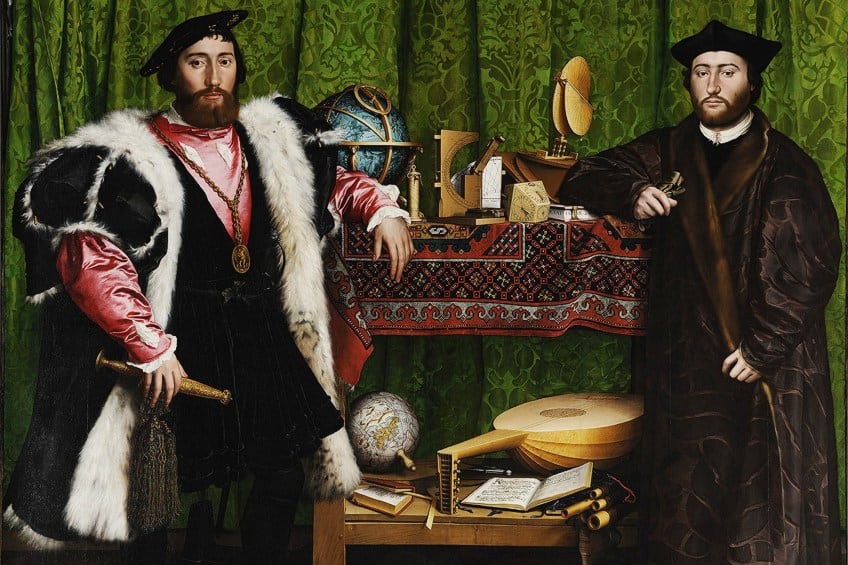


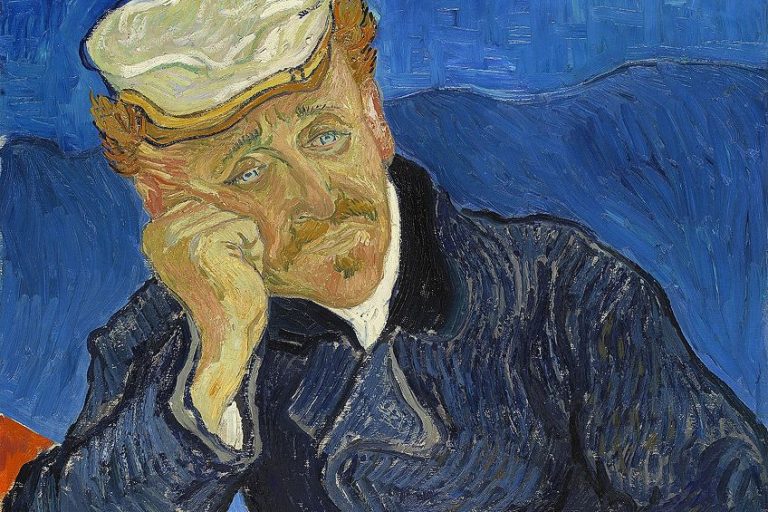
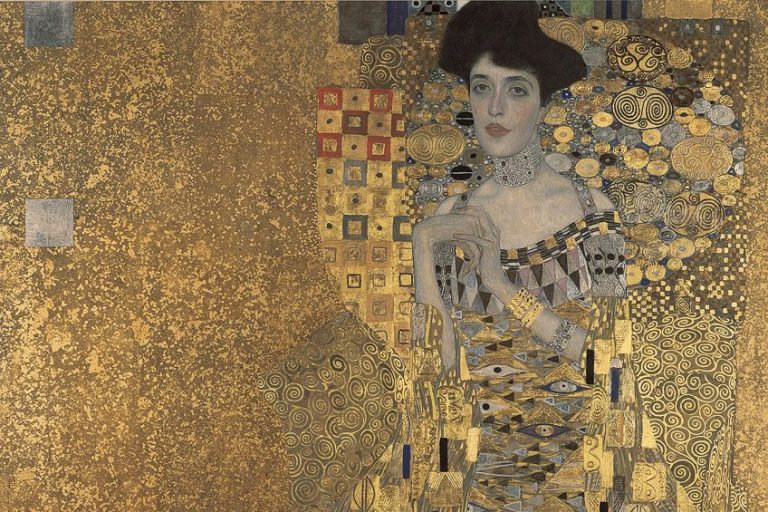

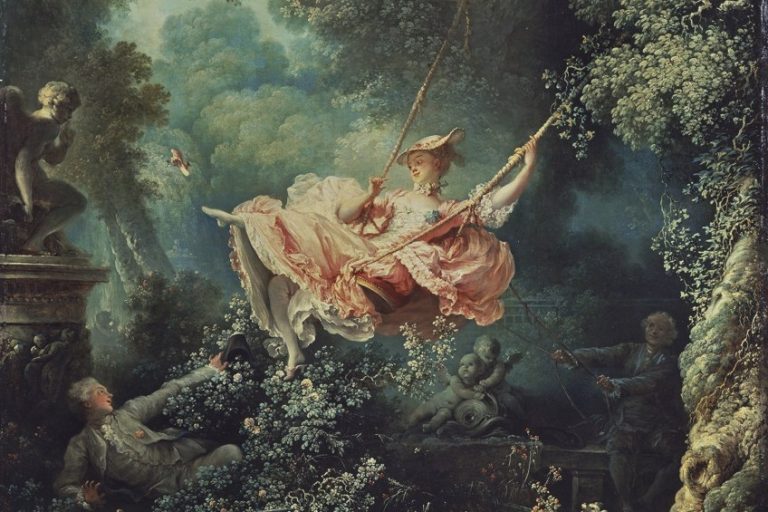



”Georges de Selve, another French diplomat, was in England and apparently was Dinteville’s friend, and he commissioned the painting as a celebration of their friendship. The two were painted when they were both in England at the time when Hans Holbein the Younger was living there around 1532”
Does this mean de Selve was the one who commissioned it, or Dinteville? ‘He’ could refer to both. In the context of the sentence, de Selve would make the most sense, but I’m confused because most other sources point to Dinteville as the commissioner.
Thanks for the response,
Just a high school student writing a paper on The Ambassadors 🙂
The ambiguity in the sentence does indeed make it unclear who commissioned the painting. However, most sources attribute the commissioning of the painting “The Ambassadors” to Jean de Dinteville, who was the French ambassador to England at the time. Georges de Selve is depicted in the painting alongside Dinteville as a close friend, but it is generally accepted that it was Dinteville who commissioned Hans Holbein the Younger to create the work.